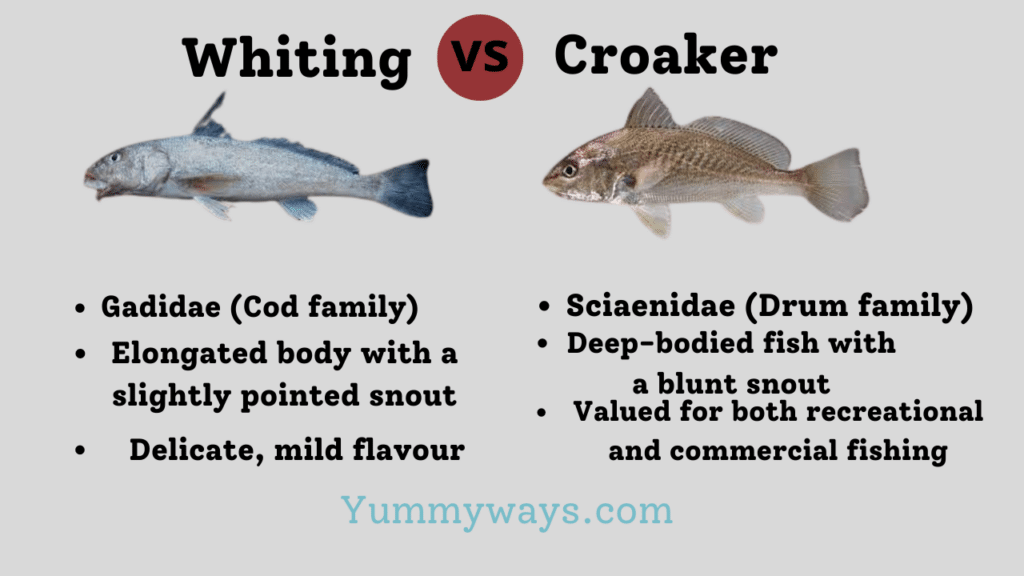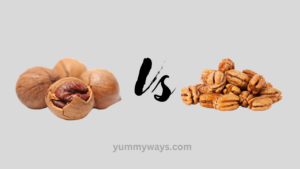Whiting and Croaker look similar but have distinct tastes, textures, and habitat differences. Discover the nuances between these two popular fish in this informative guide.
If you’re a seafood lover, you have encountered whiting and croaker at your local fish market or restaurant. While these two fish may look similar at first glance, they have unique differences in taste, texture, and where they’re typically found. In this guide, we’ll explore the nuances between whiting and croaker to help you make an informed decision next time you’re choosing between the two. So, without any delay, let’s start.

Contents
- 1 What is whiting?
- 2 What is Croaker?
- 3 Overview Of whiting vs Croaker
- 4 Detailed Differences Between Whiting vs Croaker
- 5 Which One is Better?
- 6 Conclusion
- 6.1 What is the difference between Whiting and Croaker?
- 6.2 Where can Whiting and Croaker be found?
- 6.3 What is the best time to catch Whiting and Croaker?
- 6.4 What are some popular methods for catching Whiting and Croaker?
- 6.5 What are some popular ways to cook Whiting and Croaker?
- 6.6 Are Whiting and Croaker considered sustainable fish species?
- 6.7 Can Whiting and Croaker be frozen for later use?
- 6.8 Are Whiting and Croaker suitable for people with seafood allergies?
- 6.9 Can Whiting and Croaker be found in freshwater environments?
What is whiting?
Whiting, also known as English Whiting or Merlangius merlangus, is a popular edible fish in the eastern Atlantic Ocean, ranging from the North Sea to the Bay of Biscay. It is a slender fish with a silver-white body and a slightly elongated shape.
What is Croaker?
Croaker, also called Atlantic Croaker or Micropogonias undulatus, is a species of fish native to the western Atlantic Ocean, ranging from New England to the Gulf of Mexico. It is prized for its unique croaking sound, silvery-grey appearance, and delicious, mild-flavoured flesh.
Overview Of whiting vs Croaker
| Whiting | Croaker | |
| Family | Gadidae (Cod family) | Sciaenidae (Drum family) |
| Appearance | Elongated body with a slightly pointed snout | Deep-bodied fish with a blunt snout |
| Size | Generally smaller, around 12-16 inches (30-40 cm) in length | Typically larger, ranging from 12-24 inches (30-60 cm) in length |
| Colour | Opportunistic feeders consume a variety of crustaceans, molluscs, and small fish. | Silver to bronze with a golden sheen |
| Habitat | Found in coastal waters and estuaries | Primarily inhabits shallow coastal areas and brackish waters |
| Distribution | Found in North Atlantic and North Pacific oceans | Found along the Atlantic coast of North and South America |
| Feeding Habits | Carnivorous, feeding on small fish, shrimp, and worms | A popular target for recreational anglers |
| Fishing Importance | Delicate, mild flavour | Valued for both recreational and commercial fishing |
| Taste | The sweet and slightly nutty flavor | The sweet and slightly nutty flavour |
| Culinary Uses | Often baked, grilled, or used in fish chowders | Suitable for various cooking methods, including frying and baking |
Also Read: The Ultimate Comparison: Lentils vs Quinoa
Detailed Differences Between Whiting vs Croaker
Whiting and croaker are both types of fish, but they come from different fish and have some distinct differences. Here are some detailed differences between whiting and croaker:
Family and Taxonomy
Whiting belongs to the family Gadidae, which is part of the Cod family. They are closely related to cod, haddock, and pollock. Croaker belongs to the Sciaenidae family, known as the Drum family. They are related to other drum fish like red drum and black drum.
Body Shape and Appearance
Whiting has an elongated body with a slightly pointed snout. Their streamlined shape makes them well-suited for swimming in open waters. Croaker has a deep-bodied shape with a blunt snout. They have a rounded appearance and are adapted for living near the bottom of the water column.
Size
Whiting are smaller fish with an average length of around 12-16 inches (30-40 cm). On the other hand, Croakers are larger than whiting, ranging from 12-24 inches (30-60 cm) in length.
Colouration
Whiting has a silvery or greyish colouration with a dark back and a distinct lateral line running along their sides. Croaker displays a silver to bronze colour with a golden sheen. Their scales may also have darker speckles or spots.
Also Read: Acorn vs Chestnut: Which One is the Better Nut
Habitat
Whiting is found in coastal waters and estuaries, preferring sandy or muddy bottoms. They are often encountered in the surf zone. Croaker primarily inhabits shallow coastal areas, including bays, lagoons, and estuaries. They are often found in brackish waters.
Distribution
Whiting can be found in both the North Atlantic and North Pacific oceans. They have a wider distribution and are found in various regions worldwide. Croakers are primarily found along the Atlantic coast of North and South America, from the northeastern United States to Brazil.
Feeding Habits
Whiting is carnivorous and primarily feeds on small fish, shrimp, and worms. They are agile predators that pursue their prey in the water column. Croakers are opportunistic feeders and consume a variety of food sources. Their diet includes crustaceans, molluscs, small fish, and occasionally plant matter.
Fishing Importance
Whiting is a popular target for recreational anglers, especially in areas with strong surf fishing traditions. They are also caught commercially for food. Croakers are valued for both recreational and commercial fishing. They are sought after for their good eating qualities and are often targeted by anglers.
Taste and Culinary Uses
Whiting has a delicate, mild flavour. They are often baked, grilled, or used in fish chowders and are considered good table fare. Croaker has a sweet and slightly nutty flavour. They are suitable for various cooking methods, including frying, baking, grilling, and even as whole fish for stuffing.
Also Read: Beets vs Turnips: A Comprehensive Comparison
Which One is Better?
“I have always been a fan of seafood, and I recently had the opportunity to try both whiting and croaker. In my experience, whiting stood out with its delicate flavour and firm texture. I particularly enjoyed grilling whiting fillets, which brought out their natural sweetness. On the other hand, the croaker offered a unique taste with its slightly nutty flavour and flaky texture. I found that baking croaker with some herbs and lemon created a delightful dish. Growing up near the coast, croaker holds a special place in my heart as it reminds me of family beach outings and traditional coastal recipes.”
Conclusion
Both whiting and croaker are distinct fish with unique characteristics. Whiting, belonging to the Gadidae family, has an elongated body, a mild flavour, and a firmer texture. Croaker, from the Sciaenidae family, has a deep-bodied shape, a slightly nutty flavour, and a softer, flakier texture. When deciding between whiting and croaker, personal preference plays a significant role. Some individuals prefer the delicate taste and firm texture of whiting, while others enjoy the sweet and nutty flavour and flaky texture of croaker. Availability and regional culinary traditions also influence the choice.
Both whiting and croaker are prepared using various cooking methods, making them versatile options in the kitchen. They are baked, grilled, fried, or used in soups and chowders. Exploring different recipes and cooking techniques enhances the enjoyment of both fish. The decision between whiting and croaker depends on individual taste preferences, regional availability, and cultural influences. It is recommended to try both fish to determine which one suits your palate and culinary preferences best.
What is the difference between Whiting and Croaker?
Whiting and Croaker are different species of fish, each with distinct characteristics. Whiting, also known as King George Whiting, is a silvery fish with a slender body and a mild, sweet flavour. Croaker, conversely, is a drum fish with a deeper body and a distinct croaking sound. It has a slightly stronger taste compared to Whiting.
Where can Whiting and Croaker be found?
Whiting and Croaker are primarily found in coastal waters, particularly in the Atlantic and Gulf of Mexico. They can be caught from piers, jetties, beaches, and boats in areas with sandy or muddy bottoms.
What is the best time to catch Whiting and Croaker?
Whiting and Croaker are available year-round but are more abundant during certain seasons. In many coastal areas, they can be caught most reliably in the spring and summer. However, it’s always a good idea to check local fishing regulations and consult with experienced anglers for specific regional advice.
What are some popular methods for catching Whiting and Croaker?
Anglers use a variety of techniques to catch Whiting and Croaker. Some common methods include using bottom rigs with bait such as shrimp, squid, or cut bait. These fish also bite on artificial lures like small jigs or soft plastics. Fishing with live bait, such as minnows or sand fleas, can also be effective.
What are some popular ways to cook Whiting and Croaker?
Whiting and Croaker are versatile fish that can be prepared in various ways. They are grilled, baked, broiled, pan-fried, or used in soups and stews. Popular cooking methods include coating the fish with breadcrumbs or cornmeal for a crispy texture or marinating them in flavorful sauces. Whiting and Croaker are often served with sides like rice, vegetables, or salads.
Are Whiting and Croaker considered sustainable fish species?
Both Whiting and Croaker have sustainable populations, and many fishing regulations are in place to protect their numbers. However, sustainability can vary depending on the location and fishing practices. It is always important to check local fishing regulations, follow catch limits, and consider sustainable fishing practices to ensure the long-term viability of these fish species.
Can Whiting and Croaker be frozen for later use?
Yes, Whiting and Croaker are frozen for later use. It is recommended to clean and properly store the fish in airtight containers or freezer bags to maintain freshness. When thawing, it is best to do so slowly in the refrigerator to preserve the quality of the fish.
Are Whiting and Croaker suitable for people with seafood allergies?
Whiting and Croaker are considered safe for consumption, but individual reactions to seafood can vary. If you have a known allergy to fish or seafood, it is advisable to consult with a medical professional before consuming Whiting, Croaker, or any other seafood product.
Can Whiting and Croaker be found in freshwater environments?
Whiting and Croakers are saltwater fish found in coastal or brackish waters. While finding them in estuaries or areas where freshwater meets saltwater is possible, they are not.

